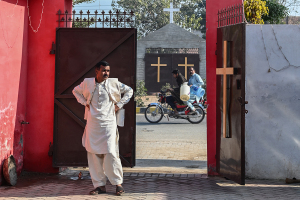Uncertainty Abounds Regarding Latest Turin Shroud Claims
As the world hears about the latest evidence that the Shroud of Turin may have been the burial cloth of Jesus, some have expressed uncertainty about the latest claim.
Giulio Fanti, a professor from the University of Padua, and Saverio Gaeta, an Italian journalist, have recently published a book arguing that the shroud did indeed exist during the time frame of the life of Jesus.
Dan Porter, who oversees a news blog about the shroud, told The Christian Post that from what he knew the research was based on "new methods that have not been peer-reviewed yet for publication in a reputable and ethical scientific journal."
"I know Giulio Fanti personally and I know him to be an honest researcher. Frankly, I would have preferred it if he had sought peer-review before writing his book," said Porter. "Unfortunately that can be difficult where science meets religion. Let's just say I am taking my time and seeking opinions from others before deciding."
Porter also told CP that regarding the whole issue that the shroud "may be the real burial cloth of Jesus."
"The carbon dating, once seemingly proving it was a medieval fake, is now widely thought of as suspect and meaningless. Even the famous atheist Richard Dawkins admits it is controversial," said Porter.
"Years ago, as a skeptic of the shroud, I came to realize that while I might believe it was a fake, I could not know so from the facts. Now, as someone who believes it is the real burial shroud of Jesus of Nazareth, I similarly realize that a leap of faith over unanswered questions is essential."
Purported to be the cloth that Jesus was buried in after the crucifixion, the Shroud of Turin first appears in the historical record around the year 1360 at the Diocese of Troyes in France. It was eventually moved to the Turin Cathedral in Northern Italy in 1578.
Much debate has existed over the authenticity of the shroud, including whether or not it was from the first century and how the famous image appeared.
In 1988, carbon dating tests were performed on the shroud, which placed its origins in the Medieval era. However, many, including Fanti, have claimed the results were faulty due to laboratory contamination.
Roy Speckhardt, executive director of the American Humanist Association, told The Christian Post that he was "very skeptical of the research."
"If the research team at the University of Padua believes that the earlier carbon dating test showing the shroud was from a different era was faulty due to contamination, why not just do another carbon dating analysis?" said Speckhardt.
"If reputable scientists are given the chance to confirm this team's results by replicating their experiments, then the new estimated date for the shroud would gain credibility. But even if the shroud was dated from the proper time period, that isn't proof that it was used on Jesus."





























